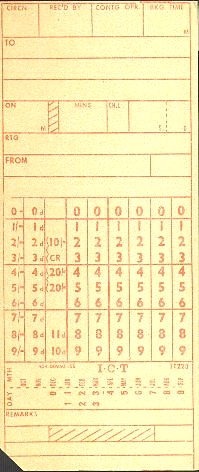
By 1960 the sorting machines (see picture below) ran at 660 cards per minute. This was the speed at which cards punched in one column in any of the 12 positions (rows) and randomly mixed could be delivered sorted into 12 receiving boxes. Suppose a group of cards were each punched using two columns with sequential numbers up to 99 and then thoroughly shuffled. If those cards were first sorted on one column, then collected together again in box order and resorted on the second column, then retrieved from the boxes and stacked in order, then all the cards would end up in numerical order. A continuation of this process using more columns could so sort numbers of any value. The very simplest data processing set-up could consist of just one sorter and a few hand punches (see picture on later page). This sorter would have an odometer type counter fitted to every receiving box. If the cards were punched from the raw data in a suitable code, the counting sorter could provide statistics. In the sixties decade the statistics relating to the causes of all deaths in the UK were derived in this manner.
A few years ago in the UK there was a television situation comedy programme entitled "The Hello Girls". This was set in a nineteen sixties telephone exchange and frequently depicted young women seated at a manual switchboard where between their gossiping they supposedly connected the calling subscribers to the required lines. However, at no time were we shown how those customers would have been charged for that service. Until 1960 each operator would have had a pad of "tickets" (also known as "flimsies") in front of her and as she handled the call would have asked for and jotted down on a ticket the calling subscriber's telephone number and when the call ended would have entered a charge based on the distance and duration of the call. These were the days before it was possible to dial one's own "trunk" calls, i.e. dial out of one's own local area, and these manual switch boards were large and numerous to deal with the increasingly large number of calls being made. Although the imminent introduction of Subscriber Trunk Dialing (STD) was expected to greatly reduce the problem, ownership of private telephones was set to expand exponentially so a modernisation of the accounting process was urgently required. STD had been partly developed before the war by the Post Office's Chief Engineer Tommy Flowers. The war diverted his effort : he was the man who built the Colossus Computers for Bletchley Park and I believe he must have been the brains behind the single program electromechanical computers built in the nineteen forties by the GPO for use in all the wartime CH RDF (radar) sites.
Part of the switchboard operators' duty was to sort into numerical order the thousands of tickets produced during their shift as the initial part of the billing process and it must have been an enormous and error prone burden to them. The real hey-day of the punched card was the second half of the thirties decade so it was a long overdue advance for those tickets to be replaced by cards as the start of a Mechanical Accounting & Trunk Sorting processs. In the early sixties the Post Office Oxford MATS unit achieved a record sorting number of over eleven million "card passages" in one week, probably using about eight sorters. A really enthusiastic operator could manage to get about three hundred and fifty thousand cards through her machine in a single day.
The size of these cards was four and threequarters by two inches and a card could accommodate forty columns of holes. In the Post Office application the cards were not printed to give any indication of where those punched columns might be, as a standard general purpose punched card was. Instead the printing was laid out to show six lines of the digits 0-9 across which the switchboard operator would draw a short pencil line. Similar lines were printed to indicate the sterling values for the operator to similarly mark. The sample on the right was kindly supplied by John Chenery whose web site has rather more to say about the GPO than mine does! Now, at the end of the shift all the operators had to do was pack all the marked cards into trays without any sorting at all. All the cards thus produced from literally many scores of telephone exchanges within a "Telephone Area" were sent by road to the nearest one of the seven "MATS Units". At Oxford the MATS unit did the accounting for the Aylesbury, Reading and Oxford telephone areas. Other MATS units existed at Chiswick, Portsmouth, Bristol, Birmingham, Leeds and Edinburgh. In addition, the smaller "pilot" installation continued work at Canterbury for a number of years.
The MATS Units were equipped with "Mark Scanning Punches". Here all the cards from one exchange were placed into the "magazine" of one of these machines When the machine was started the cards were fed one by one into the "reading" station. The pencil marks were read by photo-electric means and the appropriate holes were punched into each card after it had moved from the "reading" station into the "punch unit". The card continued through a "checking" unit where cards having insufficient or too many holes were diverted into a "rejects" receiver for manual correction by the operator. The cards flowed through the Mark Scanner at a rate of about sixty per minute.
Next the cards were passed through the sorting machines, which were rather more pristine examples than Most Local calls were directly dialled by the subscriber and in the Telephone Exchange a small meter attached to the individual line for each subscriber faithfully recorded the number of time-based "units" used. But sometimes subscribers also made local calls via the switchboard operator. Then a different type of card was marked in units for the charge. These were kept separate from the trunk call cards but were scanned at the MATS Unit in the same way. After sorting, these cards were fed through an additional High Speed Summariser machine and for whatever number of cards originating from one subscriber, a units total was punched on a separate"Summary" card. The meters recording the dialled calls were photographed together with the line number, en masse, thirty or so meters per exposure by a 35mm camera on rails which was moved along the lines of meters. A "Key Punch Operator" viewed the processed film and entered the details of each meter individually via a key pad into the automatic key punch (AKP) together with the customer's telephone number and the final key she depressed caused the data to be punched simultaneously into a "Meter" card. This card was then "verified".
The Meter card and Summary card were passed through an "Electronic Multiplying Punch" (EMP) which multiplied the number of units by the prevailing local tariff and punched the result as sterling in another area of the same card that had provided the data. These cards were then filed by hand along with the subscriber's trunk cards prior to tabulation i.e. the printing of the Telephone Bill.
So there we have the outline of the process. In additional pages I will attempt to describe the individual machines, but here to end this page I must set the scene as I experienced it in Oxford.
On leaving the Royal Airforce in June 1959 I had been accepted by a company known as ICT to fulfil the position advertised in the Daily Express for "An Electronics engineer based in Oxford." ICT had been recently formed by the merger of the British Tabulating Machine Company and the Powers Samas Company, these two being the leading data processing companies in the country at that time. Just prior to this merger, Powers had acquired a contract to supply the Post Office with a suitable system and unknown to me it was there that I would be working. However, the largest contract in the area was at Austin-Morris (BMC Service) at Cowley. So it was to there that I reported on my first day and was quite amazed and dismayed by what I had walked into :-
However, before long I was taken by John Hoidge the ICT manager down to Oxford and into the recently opened Telephone Exchange building in Speedwell street.
A very large room adjacent to the actual manual switchboard room contained a number of covered machines, a very large number of boxes of forty column cards, and a tall thin gentleman by the name of Peter Roberts. The two of us were to be responsible for keeping the various machines in good order. The room was intended to house the new STD exchange equipment, and eventually would, but in the interim it was to be the MATS Unit. But the GPO management were slow in getting their act together and we two engineers found ourselves to be there a few month too soon.
I spent some of that time undergoing training at ICT's main factory in Croydon, but the rest was idled away testing our new machines. Strangely our presence seemingly was not to be needed elsewhere by the Company during the interim period. Eventually contractors began work and a slightly raised floor was installed to permit the fitting of many brass powerpoints distributed over the area and finally a covering of very thick blue civil service linoleum was laid. Large banks of filing racks were installed down the centre of the room and then we were able finally to position the machines to the Post Office plan and retest them.
Rev260716 this older model shown here. Thus all the calls made by any particular subscriber were collected together ready for the Tabulator machines to read, accummulate totals, print the details of each call and eventually the total charge. That, in a nutshell, is the process, but of course it was rather more involved than that. In particular the charging for "Local" calls.
this older model shown here. Thus all the calls made by any particular subscriber were collected together ready for the Tabulator machines to read, accummulate totals, print the details of each call and eventually the total charge. That, in a nutshell, is the process, but of course it was rather more involved than that. In particular the charging for "Local" calls.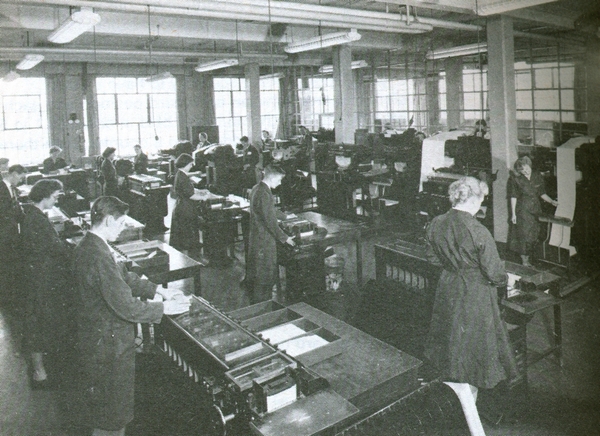
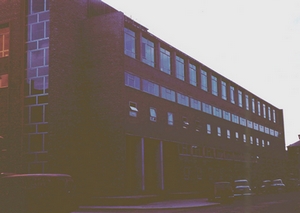
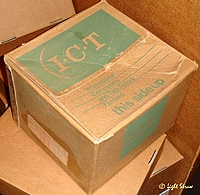
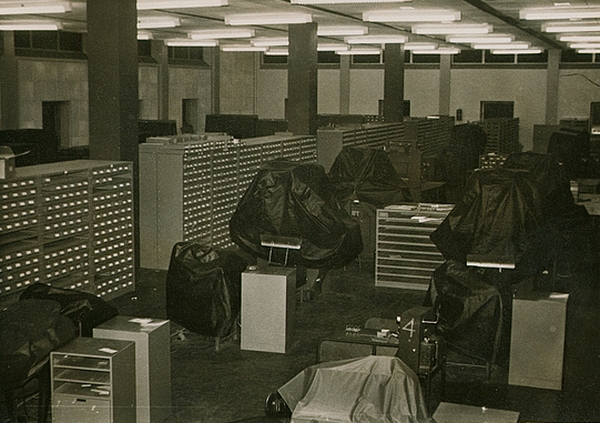
Finally a month before Christmas, a posse of ten young women arrived complete with their guardian stereotype Civil Service spinster, the formidable Miss Whitehead, posing on the right in the photo below. If you remember 'The Hello Girls' you will be able to envisage her style and her charges with uncanny accuracy! Although always artificially charming and extremely polite, she was a woman who most certainly had to be obeyed! All her girls had been trained at The Birmingham MATS unit which was already in full operation.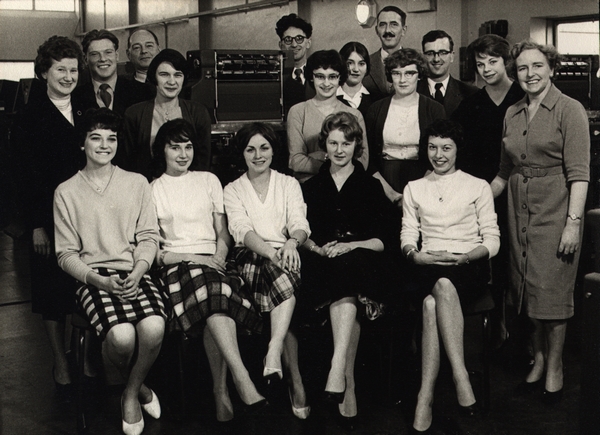
All text © 2007 D.C.Adams